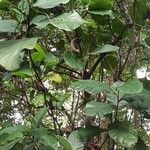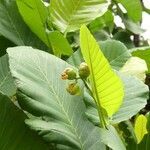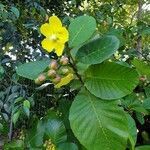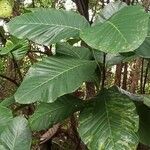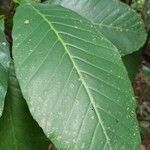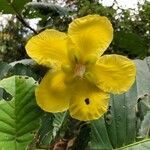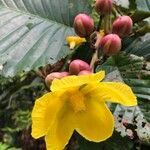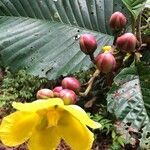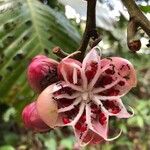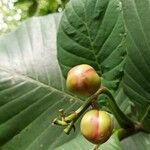Large shrub, up to 10 m high. Leaves elliptic to obovate, ca 12-20-nerved, ca 15-25 by 8-12 cm, blade with ± obtuse apex and base and entire to dentate margin, glabrous above or sometimes slightly woolly on young leaves, beneath slightly to densely woolly on the lateral nerves, on both sides of the central nerve (continuing on the petiole), and along the line which delimits the bud-enclosing part of the leaf-basis. Petiole ca 2-6 cm long with up to 1½ cm broad, usually persistent wings. Raceme usually simple, sometimes composed, ca 5-12-flowered. Flowers ca 8-11 cm diam. Sepals 5, ca 15-22 by 8-12 mm, in fruit enlarged to ca 18-25 by 10-15 mm. Petals bright yellow, ca 40-50 by 25-30 mm. Staminodes ca 100, 6 mm long. Stamens ca 175, the outer ones 8 mm long, straight in bud, the inner ones 13 mm long, with their apex reflexed in bud, with intermediate lengths. Carpels 5-8, usually 7, ca 5 by 2 mm, with yellowish white, ca 1 cm long styles, each with 7-10 ovules. Fruit dehiscent. Carpels red, ca 20-25 by 10-16 mm, each 1-4-seeded. Seeds brown or black, with a membranaceous, scarlet aril.
More
A large shrub or tree. It grows 10 m tall. The lower twigs can form roots. The leaves are oval and 15-25 cm long by 8-12 cm wide. They are woolly on the veins underneath. The flowers are 8-11 cm across and have 5 bright yellow petals. The fruit splits open and has red sections with brown or black seeds.
In marshes, along streams, and on the margin of forests, often forming thickets, from sea-level up to 500 m. Flowering continuously, each flower open for one day only, between 2 flowers of the same raceme a difference of ca 3-4 days. Fruit ripe after 36 days (CORNER, 1940); seeds eaten by birds.
More
In marshes, along streams, and on the margin of forests, often forming thickets; at elevations from sea-level up to 500 metres.
It is a tropical plant. It grows in secondary forest and swampy areas.
